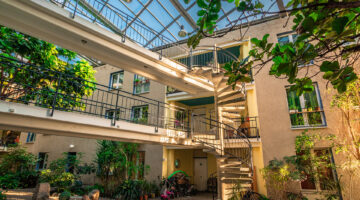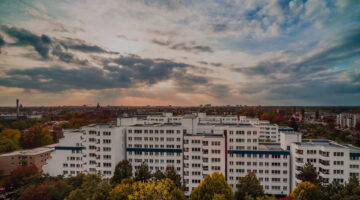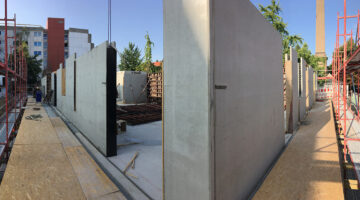


Nettelbeckplatz renovation
Main objectives of the project
The Housing Cooperative Berliner Bau- und Wohnungsgenossenschaft von 1892 eG (referred to as 1892) embarked on an experimental and forward-thinking revitalization of a housing complex dating back to the 1970s. This renovation was guided by an award-winning collaborative process, engaging a broad coalition of architects, social and healthcare organizations, and research teams from the EU-funded DREEAM project, alongside residents, neighborhood committees, and 1892 staff. The approach adopted encompassed both conventional and innovative technological solutions, including the implementation of PV energy storage. Additionally, the initiative aimed to diversify the social composition of the neighborhood by inviting various groups to reside within the estate, such as singles, families, retirees, students, artists, couples, or occupants of shared flats. To address diverse needs, the architectural strategy incorporated adaptable housing sizes and layouts, as well as the transformation of existing units into communal and public spaces, fostering a heightened sense of community and belonging. The rent increased by 1.05€/m2, but this was outweighed by energy savings. The total costs were reduced.
Date
- 2019: Rehabilitación
Stakeholders
- Promotor: Housing Cooperative 1892
- Architect: tafkaoo architects
Location
City: Berlin
Country/Region: Berlin, Germany
Description
The cooperative housing estate "Nettelbeckplatz" traces its origins to the era of stringent refurbishment strategies of the 1970s, which aimed to replace the so-called "Mietskaserne" (tenants' barracks) characterized by dimly lit rear courtyards and inhospitable living conditions. During that time, an official renewal program mandated the complete demolition of these old building areas to construct "modern" social housing structures. In 1973, the housing cooperative "1892" participated in this program, erecting a building complex reaching up to seven levels high, situated in the traditional workers' quarter of Berlin-Wedding. The original 175 apartments were arranged around a verdant courtyard featuring playgrounds and recreational spaces. The cooperative served as the cornerstone for fostering a robust local community grounded in self-help, solidarity, and self-organization.
Four decades later, the effects of demographic shifts are evident, with over 40% of the residents surpassing the age of 65. Many inhabitants now require barrier-free accommodations or assisted living options. The once-vibrant community has seen a decline in vitality and influence within the neighborhood. Moreover, the state of the building structure has deteriorated, necessitating renovation. In addition to inadequate energy standards, certain entrance areas and floor plans no longer meet contemporary needs. Compounded by social issues in the surrounding disadvantaged area, an atmosphere of insecurity and social decline has emerged.
The renovation project focused on upgrading the thermal and technical conditions of the existing building. Measures included roof insulation, window replacement, and the installation of solar panels. Furthermore, to enhance comfort and reduce heating energy consumption, windows were substituted. Renewable energy production, utilizing photovoltaic panels on the roof for common areas, was augmented with a battery storage system (Tesla PowerWall) for optimal community utilization of generated energy. Elevators were also refurbished.
The open ground floor area, where security concerns such as drug consumption were prevalent, was closed off. However, the section connecting two courtyards remained open. New dwellings were constructed in these remaining ground floor spaces to accommodate student and elderly residents, alongside the addition of communal areas, fostering a more diverse and interconnected community.
Residents actively participated in the project, engaging in a study within the DREEAM project to monitor energy consumption trends in the neighborhood. A trained group of residents exhibited 30-50% lower energy consumption compared to the control group, showcasing significant energy savings. The reduction in energy consumption, as demonstrated by the DREEAM project, was as high as 50% compared to pre-renovation measurements.
This project serves as a blueprint not only within the housing cooperative "1892" but also for other community-oriented investors. In the context of increasing urbanization, particularly in Berlin, and to counteract speculation, interdisciplinary approaches are essential to synthesize quantified growth, intelligent building design, affordability, and social values into sustainable developments. This innovative project integrates various aspects, including the renewal and further development of housing estates through multi-building strategies and integration into the surrounding neighborhood area. Insights gleaned from this project could inform the development of similar urban strategies in the future. Additionally, the project underscores the value of employee motivation stemming from involvement in a European project, providing opportunities for cross-cultural exchange and learning from counterparts in other countries.

